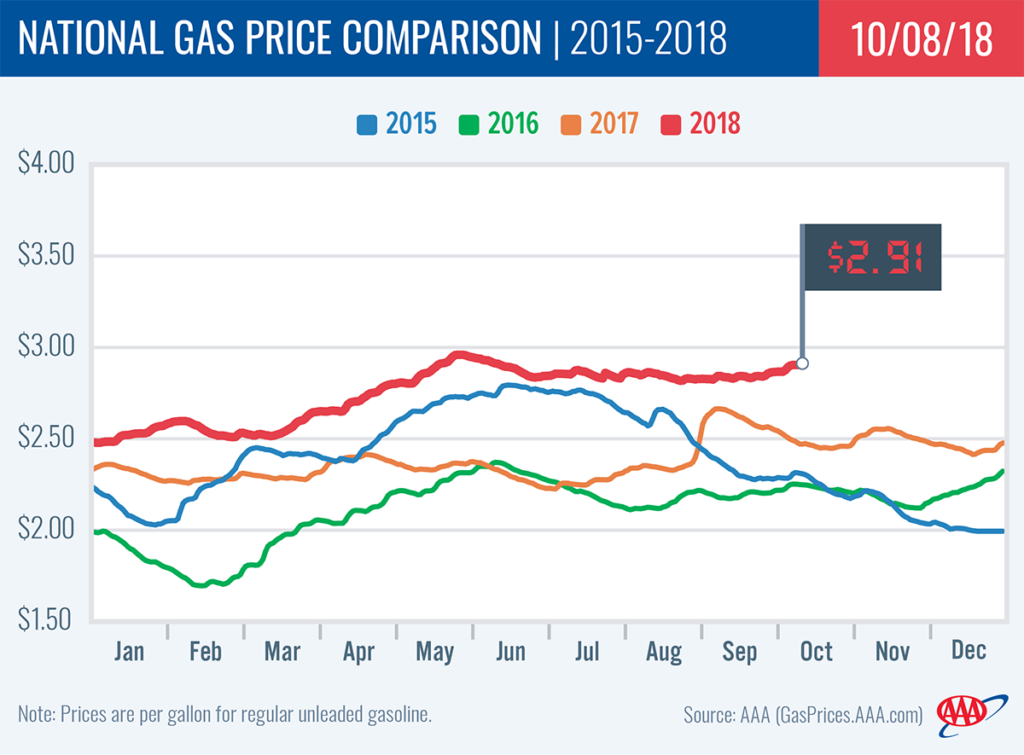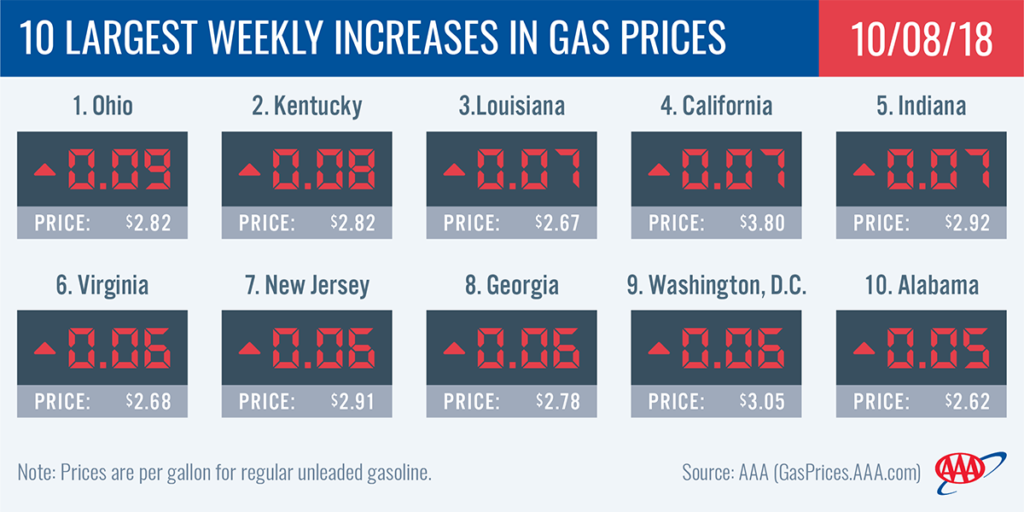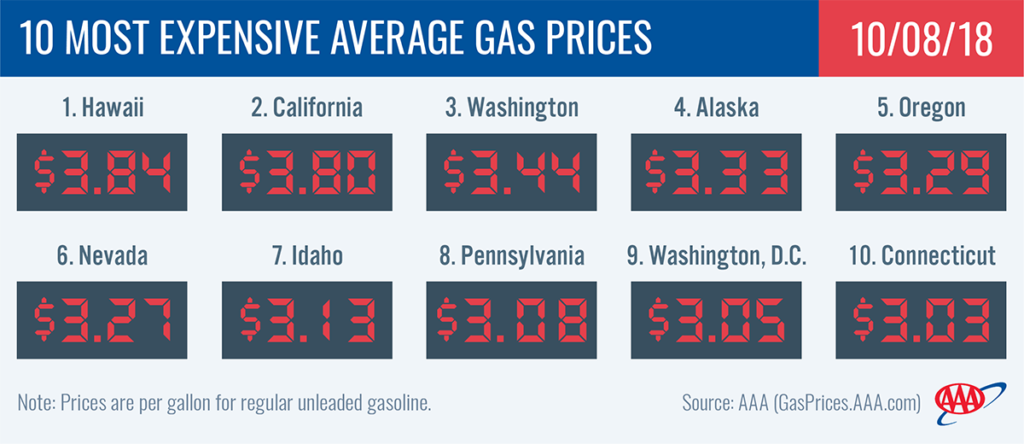The national gas price average increased three-cents on the week to $2.91. All but seven states are paying more on the week. Today’s national gas price average is six-cents more than a month ago and 41-cents more than a year ago.
“The September switch-over to winter-blend gasoline ushered in cheaper gas prices compared to the summer, but that drop was short lived,” said Jeanette Casselano, AAA spokesperson. “Crude oil accounts for half of the retail pump price and crude is selling at some of the highest price points in four years. That means fall and year-end prices are going to be unseasonably expensive.”
Crude oil has priced higher amid concerns of global crude supply and geopolitical tensions, including pending sanctions with Iran and Venezuela’s unstable economy.
As a result, fall gas prices have not been this expensive since 2014. At that time, motorists were paying on average more than $3/gal and crude oil was selling well above $70/bbl. This year, despite stocks increasing in the U.S. by 8 million bbl on the week, crude oil is selling at a good $25/bbl or more than last year, hitting $75/bbl last week.
Quick Stats
- The nation’s top 10 most expensive markets are: Hawaii ($3.84), California ($3.80), Washington ($3.44), Alaska ($3.33), Oregon ($3.29), Nevada ($3.27), Idaho ($3.13), Pennsylvania ($3.08), Washington, D.C. ($3.05) and Connecticut ($3.03).
- The nation’s top 10 largest weekly increases are: Ohio (+9 cents), Kentucky (+8 cents), Louisiana (+7 cents), California (+7 cents), Indiana (+7 cents), Virginia (+ 6 cents), New Jersey (+6 cents), Georgia (+6 cents), Washington, D.C. (+6 cents) and Alabama (+5 cents).
Great Lakes and Central
Gas prices are more expensive for every state in the Great Lakes and Central region except Wisconsin ($2.89) where prices saw no change on the week. Three states land on this week’s biggest changes list: Ohio (+9 cents), Kentucky (+8 cents) and Indiana (+7 cents). Regional refinery maintenance and expensive crude oil prices are two major factors contributing to the increase.
Compared to September, motorists are paying 5-13 cents more to fill-up in the region. Nebraska (+13 cents), Kentucky (+11 cents), Minnesota (+11 cents) and North Dakota (+11 cents) rank among the top 10 largest states in the country with the largest month-over-month increase.
Gasoline inventories dipped by 661,000 bbl, according to Energy Information Administration (EIA) data, dropping total inventories to 51.5 million bbl. Levels sit at one of the lowest for the region this year, but are comparable to this time last year. If inventories continue to decline, prices will likely continue to increase.
Mid-Atlantic and Northeast
Three states in the Mid-Atlantic and Northeast land on the top 10 list with the largest jumps in the country this week, each with a six-cent increase: Virginia ($2.68), New Jersey ($2.91) and Washington, D.C. ($3.05).
Prices have barely dipped below the $3/gal mark since May for Pennsylvania ($3.08), Washington, D.C. ($3.05), Connecticut ($3.03) and New York ($3.01).
For a second week, gasoline inventories in the Mid-Atlantic and Northeast region added more than 1.6 million bbl. Totaling at 69 million bbl, inventories sit at the highest level since June 2017. Despite the build, prices continue to increase due to more expensive crude oil.
South and Southeast
Florida ($2.82) was one of the only states in the country and the only state in the South and Southeast to see gas prices remain stable on the week. For all other states, prices increased with Louisiana (+7 cents) seeing the largest jump in the region and among the top five largest increases in the country.
Even with these increases, the region carries the top six cheapest gas prices in the country, all of which are nearly a quarter or more expensive than this time last year.
| State | Oct 8, 2018 average | Year-over-year difference |
| South Carolina | $2.61 | +27 cents |
| Mississippi | $2.61 | +30 cents |
| Alabama | $2.62 | +29 cents |
| Texas | $2.66 | +30 cents |
| Arkansas | $2.66 | +40 cents |
| Louisiana | $2.67 | +37 cents |
The latest EIA data reports gasoline inventories dropped substantially (1.9 million bbl) on the week. Despite total levels registering just below 80 million bbl, the region is sitting on a 5-million bbl year-over-year surplus.
Rockies
Utah (-4 cents) and Idaho (-3 cents) were the only states in the country to see gas prices decrease on the week. Colorado (+2 cents), Montana (+1 cent) and Wyoming (+1 cent) all saw small increases in comparison to the rest of the country.
With the changes, Utah ($3.02) and Idaho ($3.13) are trending toward some of their cheapest averages since this spring. Meanwhile, Montana ($3.01) and Colorado ($2.97) reached a new-recorded high for the year in the last week.
For a second week, gasoline inventories in the Rockies increased. EIA reports a build of 231,000 bbl for 6.9 million bbl. This is the largest inventory since early May, but was expected, given the end of peak tourism season.
West Coast
Motorists in the West Coast region are paying the highest prices for retail gasoline in the country, with six of the region’s states represented in the nation’s top 10 most expensive list. Hawaii ($3.84) is the nation’s most expensive market, followed by California ($3.80), Washington ($3.44), Alaska ($3.33), Oregon ($3.29), Nevada ($3.27), and Arizona ($2.91). All prices in the region have increased on the week, with California (+7 cents) leading the way. Nevada increased five cents, while Hawaii and Washington each increased four cents.
The EIA’s weekly petroleum status report showed West Coast gasoline stocks increased slightly to 27.89 million bbl during the week that ended on September 28. Stocks are approximately 760,000 bbl lower than where they were at this time last year, which could lead to price volatility if there are any supply shocks in the region this week.
Oil market dynamics
At the close of Friday’s formal trading session on the NYMEX, WTI increased a penny to settle at $74.34. Crude prices bounced between gains and losses last week due to concerns around the impact of U.S.-imposed sanctions on Iran, which will go into effect early next month and target Iran’s energy sector. The volatility is also attributed to concerns about the possible collapse of Venezuela’s economy. The increase in crude prices occurred despite crude oil inventories increasing by 8 million bbl to 404 million bbl last week, according to EIA. As speculation ramps up before the new sanctions on Iran take effect — which is driving increased investment in crude under the allure of even higher prices being reached later this year — crude prices will likely continue climbing next week.
In related news, Baker Hughes, Inc. reported that the U.S. lost two oil rigs last week, bringing the total to 861. However, when compared to last year at this time, there are 113 more rigs now than in 2017.
Motorists can find current gas prices along their route with the free AAA Mobile app for iPhone, iPad and Android. The app can also be used to map a route, find discounts, book a hotel and access AAA roadside assistance. Learn more at AAA.com/mobile.



